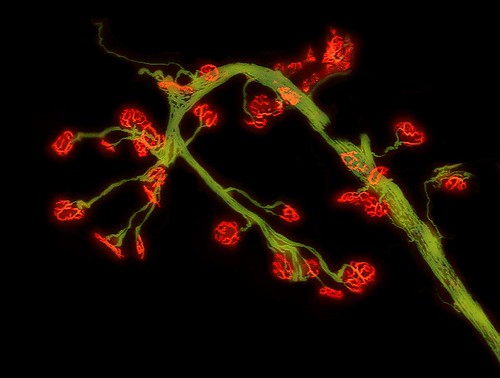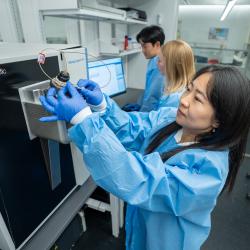UMD-led Study Could Offer Hope to Pompe Disease Patients
Researchers develop a new method that could improve enzyme replacement therapy in people with the deadly inherited disease
Pompe disease is a rare genetic disorder that disables heart and skeletal muscles and can lead to early death if untreated. The only available treatment for the disease is enzyme replacement therapy that must be injected regularly, sometimes every few days, for life. The treatment can cost hundreds of thousands of dollars a year. Researchers from the University of Maryland developed a method that could make enzyme replacement therapy more efficient, less expensive and less frequent. A study on their new method was published on August 19, 2021, in the journal Chemical Science.
“This work holds great promise for a better, less costly treatment of the life-threatening Pompe disease,” said UMD Chemistry and Biochemistry Professor Lai-Xi Wang, the corresponding author of the study.
In people with Pompe disease, the machinery inside their cells lacks a critical enzyme needed to turn glycogen into glucose, the sugar that fuels muscles. Instead of breaking down, glycogen builds up in the cells, eventually damaging muscle tissue, especially the heart.
Currently, the only treatment for Pompe disease involves injecting large amounts of the missing enzyme, known as acid alpha-glucosidase (GAA), into the bloodstream of patients—with the hope that some of it will get into the cells and clean up the built-up glycogen. But, generally, only a small amount of the enzyme reaches the cellular machinery where it is needed.
“As a result of this inefficiency, a large quantity of the enzyme needs to be injected, and the cost can go up to a half-million dollars per patient a year,” Wang said. “We have developed a simple method of modifying the enzyme that demonstrated much enhanced receptor binding, cellular uptake and glycogen degrading activity in cells.”
To develop their method, Wang and his team studied the chemical synthesis and binding properties of various molecules and discovered a ligand—a binding molecule—that was easily recognized by a specific receptor in the cellular transport system. This system carries compounds from the bloodstream across the cell membrane into the machinery where glycogen is broken down into glucose.
Once they found that ligand, Wang’s team developed a simple method to attach it to the GAA enzyme. Working with colleagues from the National Institutes of Health (NIH), the researchers tested their engineered GAA enzyme with the attached ligand in model cells and found that it was much more efficient at delivering GAA to the target machinery than the current enzyme replacement therapy.
“Our method could dramatically reduce the amount of enzyme and maybe also the frequency of injections needed to treat Pompe disease, because it ensures that more of the GAA enzyme gets into the cells’ machinery where it can do its job,” said Xiao Zhang, a postdoctoral associate in UMD’s Department of Chemistry and Biochemistry and the lead author of the study.
The research team is now doing further studies with collaborators at the NIH to evaluate the effects of the combined GAA-ligand therapy in animals with hopes of eventually moving to human trials in the future.
Pompe disease is one of about 50 diseases known as lysosome storage diseases in which cellular machinery lacks the enzymes needed to break down various waste products in cells. The researchers say the method they developed through this work could lead to improved treatments for other similar lysosome storage diseases.
###
Other co-authors of this research from UMD’s Department of Chemistry and Biochemistry include assistant research scientist Chao Li, faculty assistant Huiying Liu and postdoctoral associate Guanghui Zong.
This research was supported by the National Institutes of Health (Award No. R01 GM080374). This story does not necessarily reflect the views of this organization.
The research paper, “Chemoenzymatic glycan-selective remodeling of a therapeutic lysosomal enzyme with high-affinity M6P-glycan ligands. Enzyme substrate specificity is the name of the game,” was published in the journal Chemical Science on August 19, 2021.
Writer: Kimbra Cutlip
Media Relations Contact: Abby Robinson, 301-405-5845, abbyr@umd.edu
University of Maryland
College of Computer, Mathematical, and Natural Sciences
2300 Symons Hall
College Park, Md. 20742
www.cmns.umd.edu
@UMDscience
About the College of Computer, Mathematical, and Natural Sciences
The College of Computer, Mathematical, and Natural Sciences at the University of Maryland educates more than 9,000 future scientific leaders in its undergraduate and graduate programs each year. The college's 10 departments and more than a dozen interdisciplinary research centers foster scientific discovery with annual sponsored research funding exceeding $200 million.








